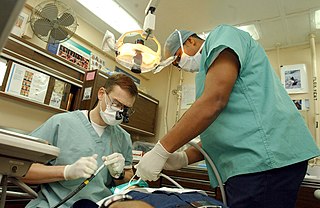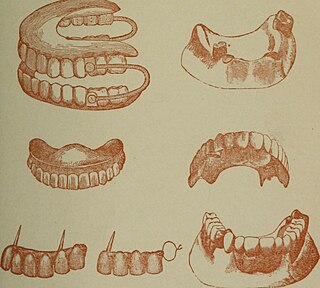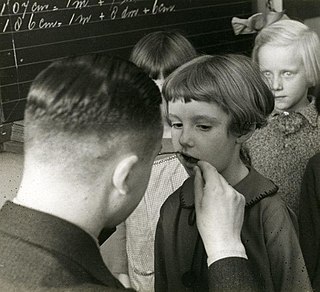Related Research Articles

Dentistry, also known as dental medicine and oral medicine, is the branch of medicine focused on the teeth, gums, and mouth. It consists of the study, diagnosis, prevention, management, and treatment of diseases, disorders, and conditions of the mouth, most commonly focused on dentition as well as the oral mucosa. Dentistry may also encompass other aspects of the craniofacial complex including the temporomandibular joint. The practitioner is called a dentist.

A dentist, also known as a dental surgeon, is a health care professional who specializes in dentistry, the branch of medicine focused on the teeth, gums, and mouth. The dentist's supporting team aids in providing oral health services. The dental team includes dental assistants, dental hygienists, dental technicians, and sometimes dental therapists.
The American Dental Association (ADA) is an American professional association established in 1859 which has more than 161,000 members. Based in the American Dental Association Building in the Near North Side of Chicago, the ADA is the world's largest and oldest national dental association. The organization lobbies on behalf of the American dental profession and provides dental accredation.
Dental sealants are a dental treatment intended to prevent tooth decay. Teeth have recesses on their biting surfaces; the back teeth have fissures (grooves) and some front teeth have cingulum pits. It is these pits and fissures that are most vulnerable to tooth decay because food and bacteria stick in them and because they are hard-to-clean areas. Dental sealants are materials placed in these pits and fissures to fill them in, creating a smooth surface which is easy to clean. Dental sealants are mainly used in children who are at higher risk of tooth decay, and are usually placed as soon as the adult molar teeth come through.

A dental hygienist or oral hygienist is a licensed dental professional, registered with a dental association or regulatory body within their country of practice. Prior to completing clinical and written board examinations, registered dental hygienists must have either an associate's or bachelor's degree in dental hygiene from an accredited college or university. Once registered, hygienists are primary healthcare professionals who work independently of or alongside dentists and other dental professionals to provide full oral health care. They have the training and education that focus on and specialize in the prevention and treatment of many oral diseases.
Periodontology or periodontics is the specialty of dentistry that studies supporting structures of teeth, as well as diseases and conditions that affect them. The supporting tissues are known as the periodontium, which includes the gingiva (gums), alveolar bone, cementum, and the periodontal ligament. A periodontist is a dentist that specializes in the prevention, diagnosis and treatment of periodontal disease and in the placement of dental implants.

Dental assistants are members of the dental team. They support a dental operator in providing more efficient dental treatment. Dental assistants are distinguished from other groups of dental auxiliaries by differing training, roles and patient scopes.
A dental auxiliary is any oral health practitioner other than a dentist & dental hygienist, including the supporting team assisting in dental treatment. They include dental assistants, dental therapists and oral health therapists, dental technologists, and orthodontic auxiliaries. The role of dental auxiliaries is usually set out in regional dental regulations, defining the treatment that can be performed.

A denturist in the United States and Canada, clinical dental technologist in the United Kingdom and Ireland, dental prosthetist in Australia, or a clinical dental technician in New Zealand is a member of the oral health care team and role as primary oral health care provider who provides an oral health examination, planning treatment, takes impressions of the surrounding oral tissues, constructs and delivers removable oral prosthesis treatment directly to the patient.
A dental spa is a dental facility supervised by a licensed Oral Health Care Provider in which dental services are provided alongside spa treatments.
SOHP is a health program of Kuwait run by The Forsyth Institute, Boston, USA. and The Ministry of Health of Kuwait.

Dental Public Health (DPH) is a para-clinical specialty of dentistry that deals with the prevention of oral disease and promotion of oral health. Dental public health is involved in the assessment of key dental health needs and coming up with effective solutions to improve the dental health of populations rather than individuals.
Alfred Civilion Fones was an American dentist from Bridgeport, Connecticut, who has been called the founder of the profession of dental hygiene, starting in 1906. Fones created the name "dental hygienist" and in 1913 established the first school of dental hygiene. Fone's father was mayor of Bridgeport from 1886-1888 and was also a practicing dentist, becoming the first "dental commissioner" for the City of Bridgeport. Alfred Fones graduated from the New York College of Dentistry in 1890.
A dental school is a tertiary educational institution—or part of such an institution—that teaches dental medicine to prospective dentists and potentially other dental auxiliaries. Dental school graduates receive a degree in Dentistry, Dental Surgery, or Dental Medicine, which, depending upon the jurisdiction, might be a bachelor's degree, master's degree, a professional degree, or a doctorate. Schools can also offer postgraduate training in general dentistry, and/or training in endodontics, oral and maxillofacial surgery, oral pathology, oral and maxillofacial radiology, orthodontics, pedodontics, periodontics, prosthodontics, dental public health, restorative dentistry, as well as postgraduate training for dental hygienists and dental technicians.
Restorative dentistry is the study, diagnosis and integrated management of diseases of the teeth and their supporting structures and the rehabilitation of the dentition to functional and aesthetic requirements of the individual. Restorative dentistry encompasses the dental specialties of endodontics, periodontics and prosthodontics and its foundation is based upon how these interact in cases requiring multifaceted care. This may require the close input from other dental specialties such as orthodontics, paediatric dentistry and special care dentistry, as well as surgical specialties such as oral and maxillofacial surgery.
Special needs dentistry, also known as special care dentistry, is a dental specialty that deals with the oral health problems of geriatric patients, patients with intellectual disabilities, and patients with other medical, physical, or psychiatric issues.

Pediatric dentistry is the branch of dentistry dealing with children from birth through adolescence. The specialty of pediatric dentistry is recognized by the American Dental Association, Royal College of Dentists of Canada, and Royal Australasian College of Dental Surgeons.
The practice of dental care in rural Alaska is overseen by the American Dental Association and other organizations under the jurisdiction of dentistry in the United States, with major differences from dentistry in the contiguous states. The oral health situation among the Alaskan Native population is among the most severe globally, with notably high rates of oral disease. Children in this population aged 2 to 5 years have almost five times the amount of tooth decay as children of the same age elsewhere in the United States, and adults have 2.5 times the amount of tooth decay as adults elsewhere. Other factors impacting the population's dental health include the difficulty of obtaining fresh food in remote locations, lack of fluoridated running water, and reduced access to education on the importance of dental health.
Dentistry provided by the National Health Service in the United Kingdom is supposed to ensure that dental treatment is available to the whole population. Most dentistry is provided by private practitioners, most of whom also provide, on a commercial basis, services which the NHS does not provide, largely cosmetic. Most adult patients have to pay some NHS charges, although these are often significantly cheaper than the cost of private dentistry. The majority of people choose NHS dental care rather than private care: as of 2005, the national average proportion of people opting for private care was 23%. NHS dentistry is not always available and is not managed in the way that other NHS services are managed.
Atraumatic restorative treatment (ART) is a method for cleaning out tooth decay from teeth using only hand instruments and placing a filling. It does not use rotary dental instruments to prepare the tooth and can be performed in settings with no access to dental equipment. No drilling or local anaesthetic injections are required. ART is considered a conservative approach, not only because it removes the decayed tissue with hand instruments, avoiding removing more tissue necessary which preserves as much tooth structure as possible, but also because it avoids pulp irritation and minimises patient discomfort. ART can be used for small, medium and deep cavities caused by dental caries.
References
- 1 2 3 Koppelman, Jane; Vitzthum, Kelly; Simon, Lisa (2016). "Expanding Where Dental Therapists Can Practice Could Increase Americans' Access to Cost-Efficient Care". Health Affairs. 35 (12): 2200–2206. doi:10.1377/hlthaff.2016.0844. ISSN 0278-2715.
- 1 2 3 4 5 Jordan, Mary (8 April 2023). "The Unexpected Political Power of Dentists". Washington Post. ISSN 0190-8286.
- 1 2 3 4 Evans, Louis W.; Sullivan, Caswell A. (19 December 2022). "Lawmakers should act on the evidence and expand access to dental therapists". STAT.
- 1 2 Friedman, Jay W.; Mathu-Muju, Kavita R. (2014). "Dental Therapists: Improving Access to Oral Health Care for Underserved Children". American Journal of Public Health. 104 (6): 1005–1009. doi:10.2105/AJPH.2014.301895. ISSN 0090-0036. PMC 4062028 . PMID 24825199 . Retrieved 15 January 2024.
- 1 2 3 "Dental therapists". Dental Abstracts. 56 (4): 179–181. 2011. doi:10.1016/j.denabs.2011.05.010.
- ↑ Satur, Julie (2009), "The development of the dental therapy profession", Cited from http://adohta.net.au/contents_uploads/file/Dental_Therapy_History.pdf Archived 26 January 2014 at the Wayback Machine 15 December 2013
- ↑ Satur, Julie. "History". Adohta.net.au. Archived from the original on 2 March 2019. Retrieved 9 May 2016.
- 1 2 3 "Education and Training". Australian Dental Association. Archived from the original on 22 March 2016. Retrieved 5 July 2023.
- 1 2 Aust Govt Dept Education. "Job Guide - OHT Australia". Australian Govt Dept Education. Archived from the original on 14 November 2011.
- 1 2 "Dental Therapist". CareerCentre.dtwd.wa.gov.au. Retrieved 9 May 2016.
- 1 2 3 4 5 6 7 8 9 10 11 12 13 14 Coats, Dawn E. "Dental Therapists and Dental Hygienists Educated for the New Zealand Environment" (PDF). International Dental Journal. Retrieved 16 March 2014.
- ↑ "Careers NZ: Dental Therapist: How to Enter the Job". 25 June 2013. Archived from the original on 12 November 2014. Retrieved 24 October 2014.
- ↑ Nash D.A., Friedman, J.W., Kardos, T.B., Kardos, L.R., Schwarz, E., Satur, J., Berg, D.G., Nasruddin, J., Mumghamba, E.G., Davenport, S.E., and Kentucky, N.R. Dental therapists: a global perspective. International Dental Journal. 2008;58:61-70.
- ↑ "Dental Students get their Teeth into new Oral Health Degree". 23 February 2007. Retrieved 24 October 2014.
- ↑ "Dental Council of New Zealand: Apply for an annual practising certificate". 2014. Retrieved 24 October 2014.
- ↑ "Dental Council of New Zealand: Fees for dental therapists". 2014. Archived from the original on 24 October 2014. Retrieved 24 October 2014.
- ↑ "Dental Council of New Zealand: Council members". 2014. Retrieved 24 October 2014.
- ↑ "Careers NZ: Dental Therapist: About the job". 27 August 2013. Archived from the original on 12 November 2014. Retrieved 24 October 2014.
- ↑ "Careers NZ: Dental Therapist: Job opportunities". 27 August 2013. Archived from the original on 12 November 2014. Retrieved 24 October 2014.
- 1 2 "About the Association". New Zealand Dental & Oral Health Therapists Association. Archived from the original on 13 January 2015. Retrieved 24 October 2014.
- ↑ Gibbons, D.E.; Corrigan, M.; Newton, J.T. (2000). "The Working Practices and Job Satisfaction of Dental Therapists: Findings of a National Survey". British Dental Journal. 189 (88): 435–438.
- ↑ "About Dental Therapy". DentalTherapy.org. National Partnership for Dental Therapy. 2024.
- 1 2 3 Standards for Dental Therapy Education Programs in the United States (PDF) (Report). Community Catalyst. October 2013.
- ↑ "Dental Therapist (DT) and Advanced Dental Therapists (ADT)". Minnesota Department of Health. Retrieved 10 January 2024.
- 1 2 "Dental Therapist". ADANSW.
- 1 2 3 "Scope of Practice Review: Oral Health Practitioners" (PDF). Health Workforce Australia. 2011. Archived from the original (PDF) on 29 February 2016.
- 1 2 3 Satur, Julie; Gussy, Mark; Marino, Rodrigo; Martini, Tamsin (2009). "Patterns of Dental Therapists Scope of Practice and Employment in Victoria, Australia". Journal of Dental Education. 3 (73): 416–425.
- 1 2 Robinson, P.G.; Dyer, T.A.; Teusner, D. (2012). "The influence of population oral health on the dental team". Community Dental Oral Epidemiology. 40 (2): 16–21.